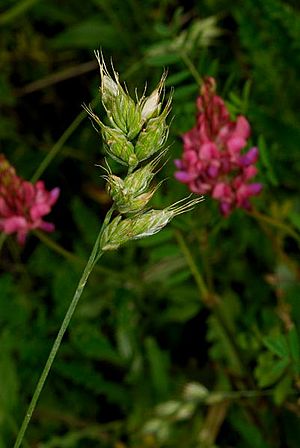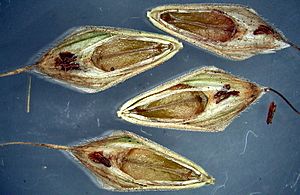Interrupted brome facts for kids
Quick facts for kids Interrupted brome |
|
|---|---|
 |
|
| Bromus interruptus flowering spike with sainfoin flowering in the background | |
| Conservation status | |
| Scientific classification | |
| Genus: |
Bromus
|
| Species: |
interruptus
|
| Synonyms | |
|
Bromus mollis var. interruptus Hack. |
|
The interrupted brome (Bromus interruptus) is a type of flowering plant in the grass family. It used to grow only in southern and central England. Sadly, it disappeared from the wild in 1972. But after being grown by people for many years, it was brought back to the Aston Rowant National Nature Reserve in 2004. This was the first time an extinct plant was brought back to the wild in Britain!
This grass often grew as a weed in fields, especially where farmers grew sainfoin (a plant used for animal food). You can tell it apart from other similar grasses because its inner flower part, called a palea, is deeply split in two.
Scientists think this plant appeared suddenly in the 1800s due to a big genetic change. It spread quickly after it was first found in 1849. The interrupted brome started to disappear when cars and tractors replaced horses. This meant farmers grew less sainfoin, which was food for horses. Also, better ways of cleaning seeds helped remove the grass from crops.
Contents
What Does It Look Like?
The interrupted brome is a plant that lives for one or two years. It has thin or somewhat thick stems, called culms, that grow 20 to 100 cm tall. They can grow in loose groups or by themselves.
Stems and Leaves
The stems stand straight up and have a few soft hairs. They usually have 2 to 4 nodes, which are like small bumps. The green leaves are long and thin, measuring 6 to 20 cm long and 2 to 6 mm wide. They have a pointed tip and are covered in soft hairs.
The leaf sheaths, which wrap around the stem, are like tubes. The lower part has soft hairs, and the upper part has shorter hairs. The ligules, a small flap at the base of the leaf blade, are 1 to 2 mm long and have a jagged edge.
Flowers and Seeds
The flowers grow in a dense, oblong cluster called a panicle. This cluster is 2 to 9 cm long and up to 20 mm thick. It stands upright and is usually greyish-green. As its name suggests, the cluster is often "interrupted," meaning it has gaps. Sometimes, it can even be just a single spikelet.
The spikelets are small clusters of flowers. They are 10 to 15 mm long and 5 to 8 mm wide. They are plump and egg-shaped, covered in soft hairs. Each spikelet has 5 to 11 flowers. When they are ripe, they slowly break apart below each lemma.
The glumes are like sterile husks at the bottom of each spikelet. They are different sizes and stay on the plant after it matures. The lower glume is 5 to 7 mm long, and the upper one is a bit bigger, 6 to 9 mm long.
The lemmas are the outer husks that cover a flower. They are 7.5 to 9 mm long and 5 to 5.5 mm wide. They have 7 to 9 clear veins and two tiny teeth. Each lemma has a thin, rough awn (a bristle-like part) that is 4 to 8 mm long.
The paleas are the inner husks that cover a flower. They are shorter than the lemmas and are split in two all the way to the bottom. This split palea is what makes the interrupted brome different from all other grasses in its group. Each spikelet has 5 to 8 flowers. The anthers are 1 to 1.5 mm long. The seed, called a caryopsis, is tightly enclosed and has a narrow oval shape. The plant has 28 chromosomes.
Where Does It Grow?
The interrupted brome is a plant that is endemic to south-central and south-eastern England. It used to be found from southern Lincolnshire down to eastern Kent and northern Somerset. It was last seen growing in the wild in Cambridgeshire in 1972. Today, it is listed as extinct in the wild.
Its disappearance happened because of better ways to clean seeds. These methods removed the grass seeds from crop seeds, which meant the plant could no longer grow as a weed. Since then, the plant has only survived because people have grown it in gardens and special collections in the United Kingdom. It has also been introduced to the Netherlands, where it now grows.
The plant mostly grew in wild, unused areas and as a weed in farm fields. It was especially common in fields of sainfoin (Onobrychis viciifolia), rye grass (Lolium perenne), and clover (Trifolium sp.). You could also find it growing along roadsides and paths.
Coming Back to the Wild
Philip M. Smith (1941–2004), a botanist from the University of Edinburgh, studied brome grasses. In the 1970s, he collected seeds from the last group of interrupted brome plants in Cambridge. He planted these seeds and grew the plants in a pot on his window sill. In 1979, he shared seeds with other scientists at a conference. Because of him, the plants started to be grown at the Royal Botanic Gardens in Kew and Edinburgh.
Stewart Henchie, a botanist from Kew Gardens, started a project to bring the interrupted brome back into the wild. Under his guidance, Kew Gardens and Paignton Zoo grew many of these plants to get enough seeds for re-introduction.
In 2003, some seeds were planted on a farm in Whittlesford, Cambridgeshire. This was the first time the plant was introduced back into the wild under Stewart Henchie's supervision. These plants grew and lasted until 2006. In the summer of 2004, more seeds were spread at English Nature's Aston Rowant National Nature Reserve in the Chilterns. These plants grew successfully, produced fruit, and continued to live. This was a big moment, as it was the first time an extinct plant was brought back to the wild in British history!
See also
 In Spanish: Bromus interruptus para niños
In Spanish: Bromus interruptus para niños



